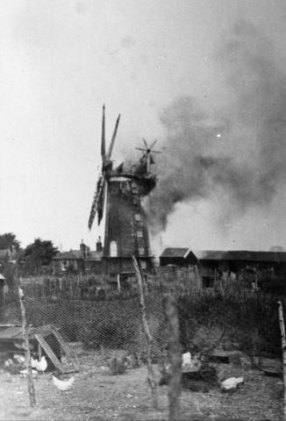Last Friday, Talbot Green, a stalwart volunteer, reached a milestone – uploading the 3500th press cutting onto our Archive Catalogue. It recorded a significant event – Wangford Smock Mill, Suffolk ablaze on 7 August 1928 as it crashed to the ground!

Fire is an ever present risk as flour is highly combustible. Added to a largely wooden structure, mill fires quickly consume everything in their path. This terrible blaze was no exception. Today we use mobile phones to record terrible events, but one quick-thinking local photographer recorded the fire as it gathered pace.
An accompanying article from the East Anglian Daily Times described the event in dramatic detail. Here I have used images from Peter Dolman’s collection to show the working mill in 1905 and illustrate the different stages of the fire in 1928, as described in the newspaper article.
Wangford Smock Mill as a working mill c1905 (Peter Dolman Collection):

The fire began at the top of the mill. Mrs Cooper spotted smoke coming from the top of the mill from her garden at 11am.

She ran to the mill to alert Mr Martin the miller and his brother who were working in the mill. He raised the alarm and tried to put out the flames but was beaten back by the heat.

PC Reynolds quickly arrived and, realising that the mill couldn’t be saved, he organised a salvage operation to rescue the contents of the nearby cottage that was in danger from the fire. A human chain was formed from the crowd of locals now gathering.

Southwold Fire Brigade arrived 20 minutes after the alarm was raised, but the only water available in large quantities was from the river half a mile away but their hoses didn’t stretch that far, so they had to send for extra lengths of hose. By then the crowd had swelled to hundreds and all everyone could do was watch as the mill succumbed to its fate.
Eventually, the mill collapsed and the fire also engulfed the cottage but at least PC Reynolds’ action had rescued the furniture and some of the belongings.

Thankfully no-one was injured or killed though the Martins lost their livelihood and their home that morning. Only after the fire had died down did anyone realise that a 50 gallon petrol tank was close-by; with all the people standing around, the conflagration could have been so much worse.
We have over 200 images and many reports of mill fires in the archive collections so do explore the catalogue for other stories. However, we shall have to wait a while for Talbot to upload the 4000th press cutting but I’m sure that it will be another interesting story to write about.